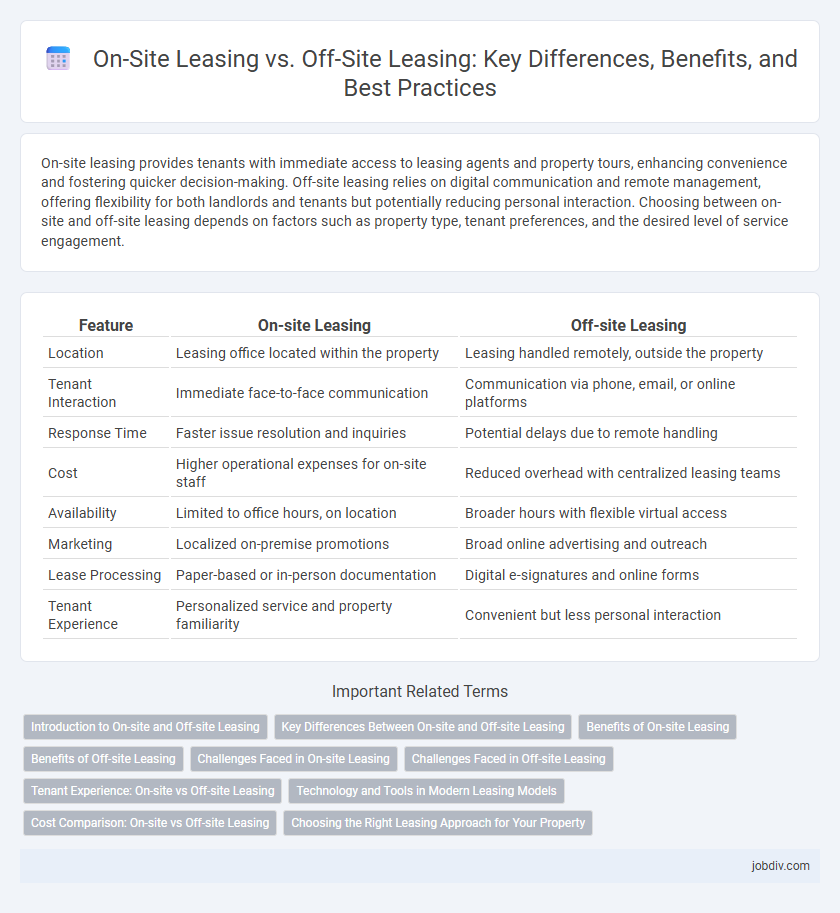On-site leasing provides tenants with immediate access to leasing agents and property tours, enhancing convenience and fostering quicker decision-making. Off-site leasing relies on digital communication and remote management, offering flexibility for both landlords and tenants but potentially reducing personal interaction. Choosing between on-site and off-site leasing depends on factors such as property type, tenant preferences, and the desired level of service engagement.
Table of Comparison
| Feature | On-site Leasing | Off-site Leasing |
|---|---|---|
| Location | Leasing office located within the property | Leasing handled remotely, outside the property |
| Tenant Interaction | Immediate face-to-face communication | Communication via phone, email, or online platforms |
| Response Time | Faster issue resolution and inquiries | Potential delays due to remote handling |
| Cost | Higher operational expenses for on-site staff | Reduced overhead with centralized leasing teams |
| Availability | Limited to office hours, on location | Broader hours with flexible virtual access |
| Marketing | Localized on-premise promotions | Broad online advertising and outreach |
| Lease Processing | Paper-based or in-person documentation | Digital e-signatures and online forms |
| Tenant Experience | Personalized service and property familiarity | Convenient but less personal interaction |
Introduction to On-site and Off-site Leasing
On-site leasing involves property managers or leasing agents working directly at the property location, providing immediate assistance and personalized tours to prospective tenants. Off-site leasing operates remotely, often relying on digital communication and virtual tours to engage potential renters without physical presence at the property. Both methods aim to enhance tenant acquisition but differ in accessibility and interaction levels.
Key Differences Between On-site and Off-site Leasing
On-site leasing involves property management and leasing activities conducted directly at the property location, providing immediate customer service and property tours, which enhances tenant engagement and satisfaction. Off-site leasing operates remotely, utilizing digital platforms and call centers to manage inquiries and applications, often reducing overhead costs but potentially limiting personal interaction and timely property access. Key differences include the level of tenant interaction, operational cost, and accessibility to the physical property during the leasing process.
Benefits of On-site Leasing
On-site leasing enhances tenant satisfaction through immediate property access and personalized service, leading to faster lease agreements and higher occupancy rates. On-site leasing teams can address maintenance requests and tenant concerns promptly, improving overall resident retention and community engagement. This approach also allows property managers to conduct real-time market analysis, optimizing rental pricing and marketing strategies efficiently.
Benefits of Off-site Leasing
Off-site leasing offers greater flexibility by allowing prospective tenants to explore multiple properties without geographic constraints, enhancing reach to a broader audience. This method reduces operational costs associated with maintaining on-site leasing offices, resulting in better resource allocation for marketing and tenant engagement. Digital tools integrated into off-site leasing streamline the application process and provide real-time availability updates, significantly improving customer convenience and satisfaction.
Challenges Faced in On-site Leasing
On-site leasing presents challenges such as limited availability of leasing agents during peak hours, causing potential delays in tenant assistance and lease processing. Physical space constraints can hinder effective presentations and limit access to necessary resources, reducing operational efficiency. High dependency on location foot traffic makes tenant acquisition unpredictable and susceptible to local market fluctuations.
Challenges Faced in Off-site Leasing
Off-site leasing presents challenges such as reduced ability to conduct thorough property inspections, leading to potential miscommunication about unit conditions. Limited face-to-face interaction can hinder relationship building with prospective tenants, impacting trust and satisfaction. Managing maintenance requests and coordinating with on-site staff remotely often results in slower response times and increased operational complexity.
Tenant Experience: On-site vs Off-site Leasing
On-site leasing enhances tenant experience by providing immediate access to leasing agents for personalized support, quicker issue resolution, and guided property tours, fostering a stronger community connection. Off-site leasing offers convenience and flexibility through online applications and virtual tours, catering to tenants who prioritize digital interactions and time efficiency. The choice between on-site and off-site leasing significantly impacts tenant satisfaction, with on-site often preferred for hands-on service and off-site favored for streamlined, tech-driven processes.
Technology and Tools in Modern Leasing Models
On-site leasing integrates advanced technology such as virtual tours, AI-driven tenant screening, and real-time communication platforms to streamline the leasing process directly at the property location. Off-site leasing leverages cloud-based CRM systems, digital document signing, and remote support tools to facilitate leasing activities without physical presence, enhancing flexibility and accessibility. Both models increasingly rely on data analytics and mobile applications to optimize tenant engagement and operational efficiency in modern leasing strategies.
Cost Comparison: On-site vs Off-site Leasing
On-site leasing typically incurs higher operational costs due to the need for dedicated office space, staff salaries, and maintenance expenses, whereas off-site leasing allows companies to reduce overhead by utilizing remote agents or third-party services. However, on-site leasing can increase tenant engagement and faster turnaround, potentially offsetting increased costs with higher occupancy rates. Off-site leasing offers greater flexibility and scalability, lowering fixed costs but may sacrifice personalized service, impacting tenant retention and long-term revenue.
Choosing the Right Leasing Approach for Your Property
On-site leasing offers direct interaction with potential tenants and immediate property access, fostering personalized experiences and quicker decision-making. Off-site leasing leverages remote tools and digital platforms to reach a broader audience, reducing overhead costs and increasing convenience. Selecting the right leasing approach depends on property type, target market, and the balance between personal engagement and operational efficiency.
On-site Leasing vs Off-site Leasing Infographic

 jobdiv.com
jobdiv.com